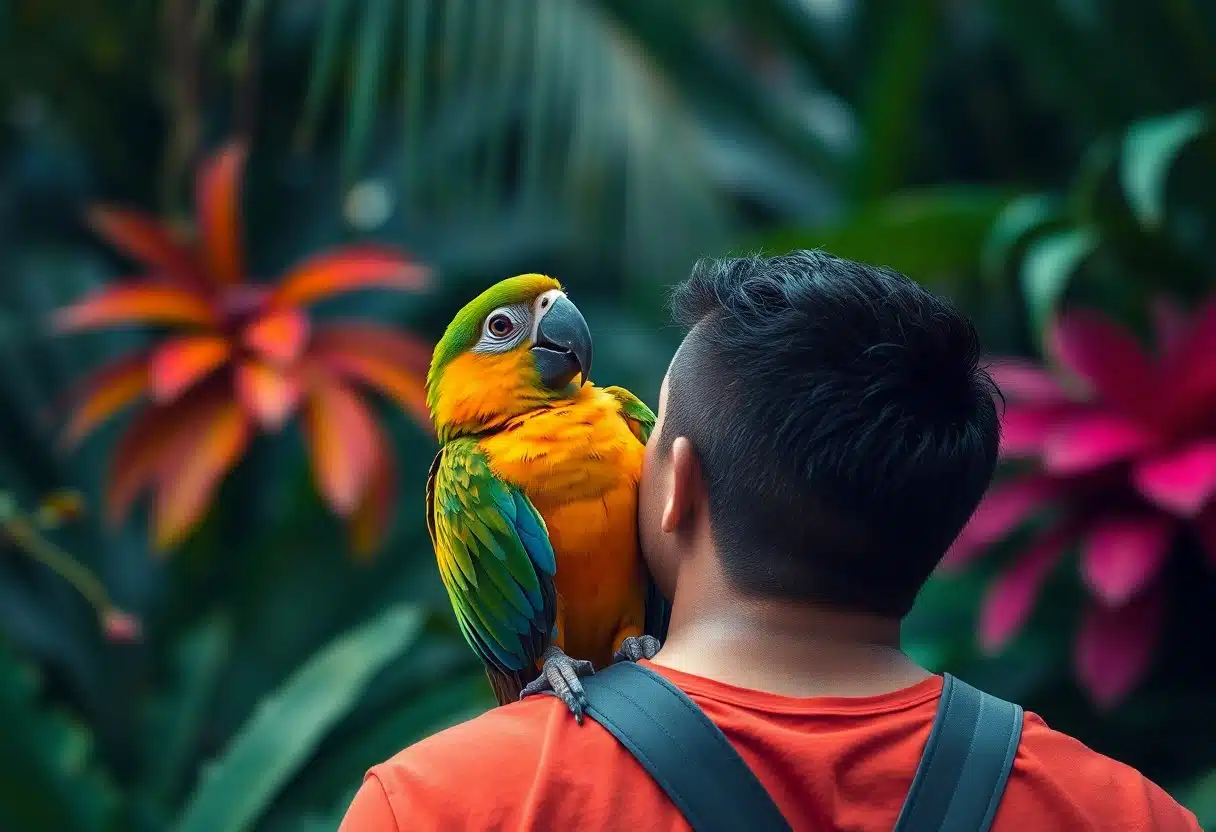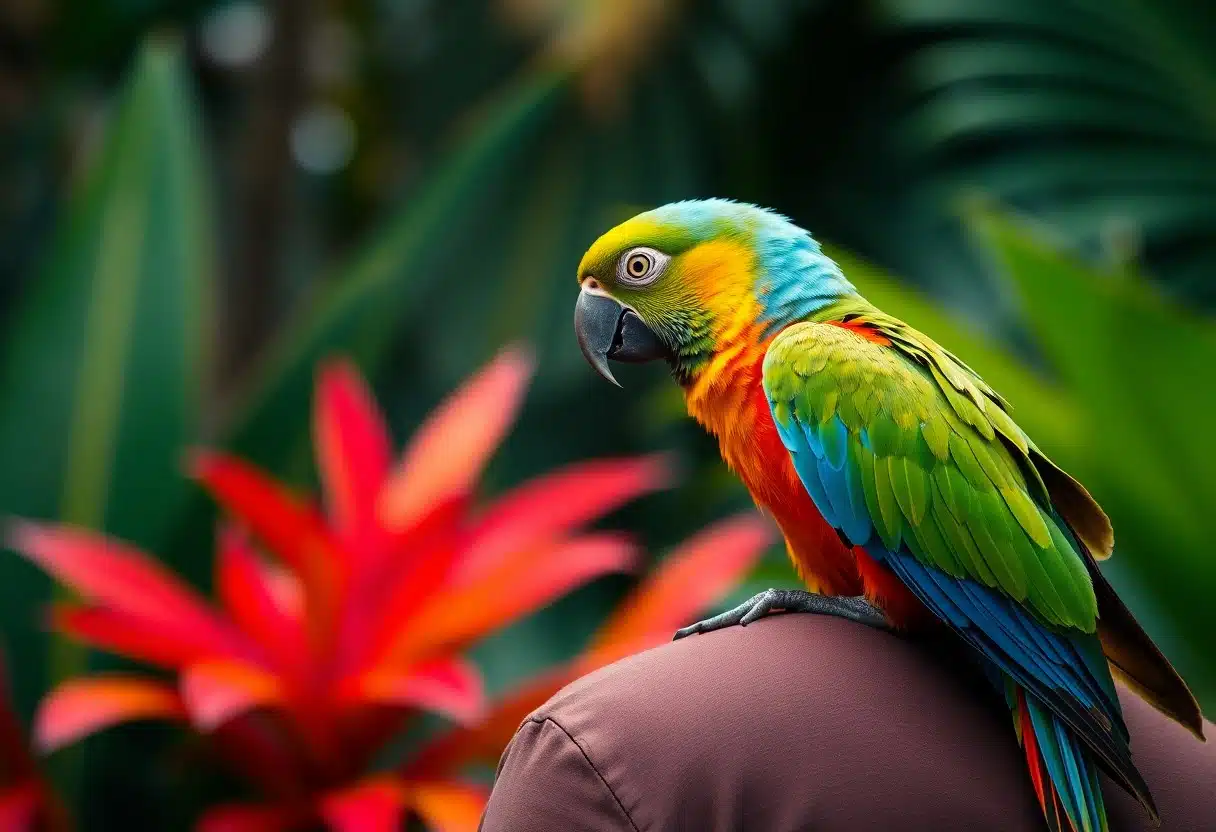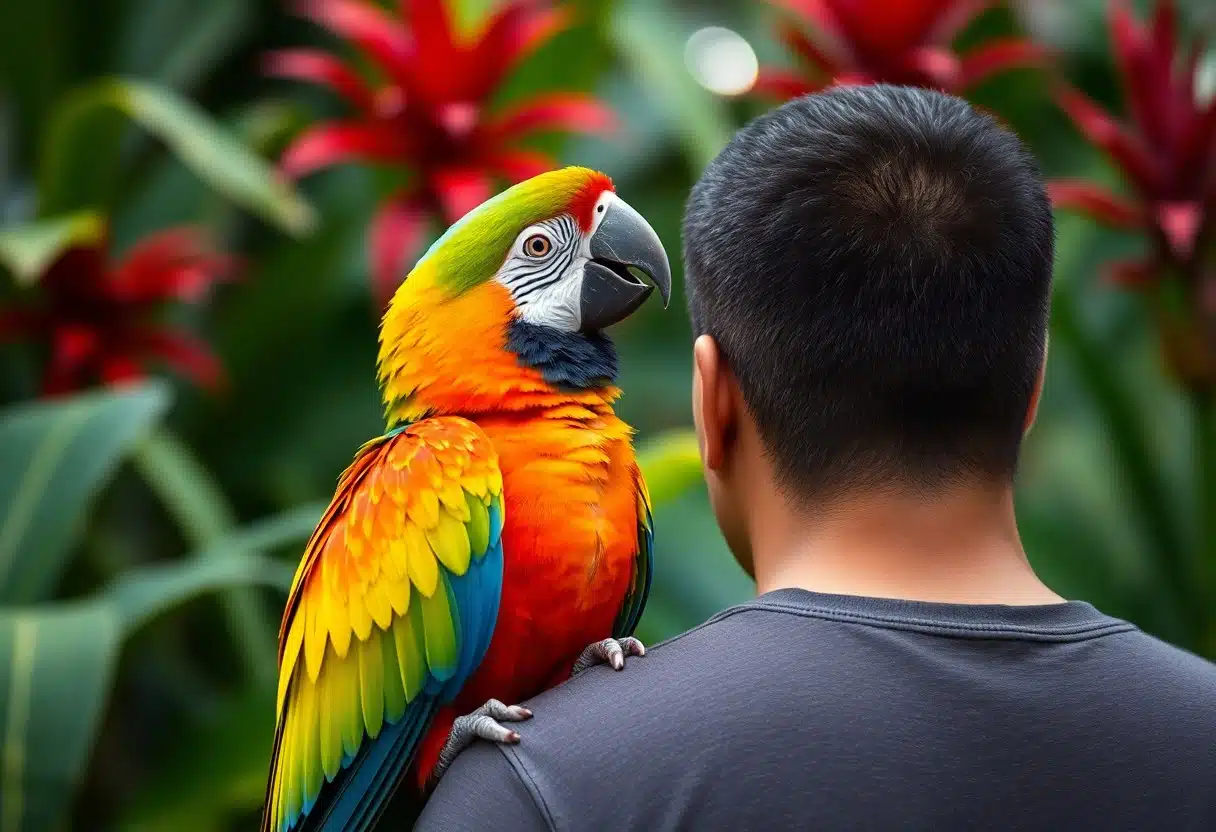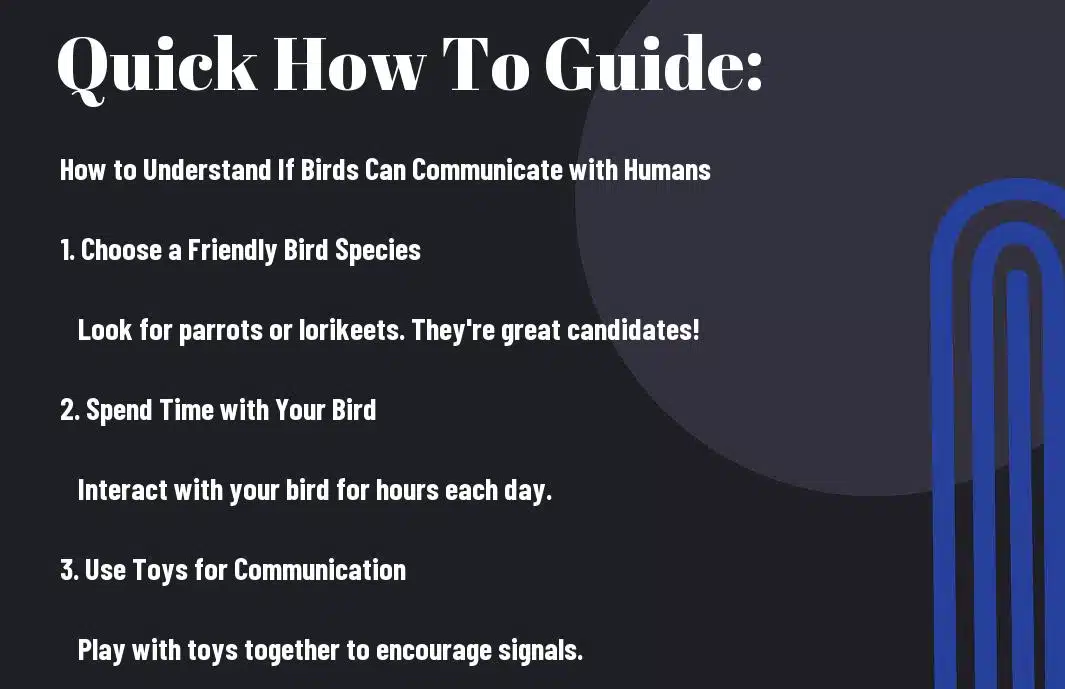Can Birds Communicate with Humans?
Have you ever wondered if birds can really talk to us? As you watch your pet parrot mimic your words or observe wild birds interacting with each other, you might have asked yourself: can birds truly communicate with humans? The answer is not a simple yes or no. While birds don’t possess a language like humans do, research suggests that they are capable of complex communication.
In fact, studies have shown that some bird species can learn and mimic human speech, and even understand certain words and phrases. But how do they do it? And what can we learn from their unique communication system? In this article, we’ll explore the fascinating world of bird-human communication and uncover the surprising similarities between our brains and theirs, including how we both use signals to convey information.
Key Takeaways:
- Birds can learn human-like language: Songbirds, like humans, have the ability to learn and mimic complex sounds, including language. This is made possible by a specialized circuit in their brain, similar to the one found in mammals.
- Early exposure shapes communication skills: Research shows that the sounds a bird is exposed to early in life shape its ability to learn and communicate. This is similar to how human babies learn language from their parents.
- Birds and humans have similar brain structures: Studies have found that songbirds and mammals have similar brain structures, including the canonical cortical microcircuit, which is key to complex cognitive abilities and social communication skills.
“The future lies in uncovering how we take this all-purpose sound processor we have at birth and, over time, end up with populations of neurons that are in fact finely tuned for the exact types of sounds that the brain uses to communicate throughout its lifetime.” – Dr. Sarah Woolley

How to Understand Bird Communication
While understanding bird communication is a complex task, there are ways to improve your chances of deciphering their language. By paying attention to their behavior, vocalizations, and body language, you can gain insight into their communication system.
Factors Influencing Auditory Perception
For instance, research suggests that auditory perception is influenced by various factors, including:
- Vocal learning is a crucial signal in the development of communication skills in birds.: The ability of birds to learn and mimic sounds, similar to humans.
- Early exposureThe sounds a bird is exposed to early in life can shape its auditory perception and serve as a signal for its future communication.
- Social contactClose social contact with other birds can influence a bird’s vocal learning and communication style, enhancing their ability to use signals.
Recognizing these factors can help you better understand how birds communicate with each other and even with humans.
The Role of Vocal Learning in Songbirds
Assuming that birds have a similar language learning process to humans, researchers have been studying songbirds to understand how they acquire and develop their vocalizations.
To understand this process, researchers have been studying how songbirds learn to sing by mimicking their fathers. This complex process involves the development of specialized neural circuits in the brain, similar to those found in humans. By studying these circuits, researchers hope to gain insight into how birds learn to communicate and how this process compares to human language acquisition.
In fact, research has shown that songbirds have a similar cortical microcircuit to mammals, which allows them to receive and interpret complex sounds and develop complex behaviors. This similarity highlights the importance of vocal learning in songbirds and its potential to inform our understanding of human language acquisition.
Tips for Studying Bird Brain Development
You can probe deeper into the fascinating world of bird cognition by exploring the development of their brains. To do so, follow these tips:
- Investigate early experience and auditory development to understand how birds learn and interpret sounds.
- Uncover similarities between bird and mammal brains to identify parallels in cognitive abilities.
Assume that by studying bird brain development, you’ll gain valuable insights into the complexities of avian behavior and communication.
Investigating Early Experience and Auditory Development
Early exposure to sounds plays a critical role in shaping a bird’s brain development. Research has shown that songbirds, like humans, learn to vocalize through progressive stages of imitation and trial-and-error.
Uncovering Similarities between Bird and Mammal Brains
Assuming that birds and mammals share similar cognitive abilities, researchers have discovered that songbirds possess a specialized circuit analogous to the canonical cortical microcircuit found in mammals.
Between these two species, researchers have identified striking similarities in brain structure and function, particularly in the auditory cortex, which helps process various signals. This has led to a greater understanding of how birds and mammals process and interpret complex sounds, and how these abilities develop over time.
How to Learn from Songbirds
Your journey to understanding bird-human communication begins with learning from songbirds. These avian creatures have been observed to possess remarkable vocal learning abilities, similar to those of humans. By studying their behavior, you can gain valuable insights into the intricacies of communication.
The Importance of Social Contact in Vocal Learning
Vocal learning in songbirds is deeply rooted in social contact. Research has shown that young birds learn to sing by mimicking their fathers, and this process is critical for their survival. In fact, studies have revealed that baby songbirds can learn the songs of their adoptive fathers, even if their biological father is present. This highlights the significance of close social contact in vocal learning.
Adapting to New Sounds and Songs
Adapting to new sounds and songs is a crucial aspect of vocal learning in songbirds, which often involves the use of their beak to produce varied signals. By exposing themselves to different sounds and sequences, young birds can develop their auditory cortex neurons, allowing them to perceive and interpret complex sounds. This process is crucial for their ability to learn and mimic new songs.
Songs learned during this period can shape the bird’s behavior and even influence its mating choices, as these signals attract potential partners. In fact, research has shown that female songbirds choose their mates based on the quality of their song, which serves as an attractive signal during courtship. This emphasizes the importance of adapting to new sounds and songs in the early stages of life.
Important note: The brain’s ability to adapt to new sounds and songs decreases with age, making early exposure critical for vocal learning.
“The future lies in uncovering how we take this all-purpose sound processor we have at birth and, over time, end up with populations of neurons that are in fact finely tuned for the exact types of sounds that the brain uses communicate throughout its lifetime.” – Dr. Sarah Woolley
Factors Affecting Brain Adaptation
To understand how birds communicate with humans, it’s imperative to explore the factors that influence brain adaptation. Brain plasticity, or the brain’s ability to reorganize itself, plays a significant role in language development. Research suggests that early exposure to sounds and social interaction are critical components of vocal learning.
For instance, a study found that songbirds can learn the songs of their adoptive fathers, even if they’re from a different species, highlighting the importance of close social contact in language development. Do Birds Have Language? Any attempt to understand bird-human communication must consider these factors.
The Role of Neurons in Perceiving and Interpreting Sounds
Role of neurons in perceiving and interpreting sounds is crucial in understanding language development. In songbirds, auditory cortex neurons are responsible for processing and interpreting complex sounds. Research has shown that these neurons are highly adaptable, allowing young birds to learn and mimic the songs of their adoptive fathers.
Observing Patterns in Auditory Cortex Neurons
One key aspect of studying language development is observing patterns in auditory cortex neurons. By recording the activity of these neurons in awake birds, researchers can gain insights into how different species acquire song. For example, a study found that the underlying mechanisms in the brain by which each species learned to sing were not revealed in the neurons’ responses to individual tones.
This study highlights the importance of early exposure to sounds in shaping the brain’s ability to process and interpret language signals effectively. The findings suggest that the brain’s capacity for learning emerges over time based on the sounds the birds are exposed to early on. This has significant implications for our understanding of language development in both birds and humans.

How to Apply Bird Communication Insights to Humans
Now that we’ve explored the fascinating world of bird communication, let’s discuss how these insights can be applied to humans. By studying the ways in which birds learn and communicate, we can gain a deeper understanding of our own language acquisition and development.
The Malleability of Auditory Cortex Neurons in Infants
Newborns are incredibly adept at learning and adapting to their environment, and this is particularly evident in their ability to distinguish between different sounds and languages. Research has shown that the auditory cortex neurons in infants are highly malleable, allowing them to quickly adapt to the sounds and rhythms of their native language.
Implications for Language Acquisition and Development
With this knowledge, we can better understand how language acquisition works in humans. Just like songbirds, human infants learn to communicate by mimicking the sounds and rhythms they hear around them. This process is crucial for language development, and understanding how it works can help us develop more effective language learning strategies.
This research also has implications for language learning in adulthood. While our brains are less malleable than those of infants, we can still learn new languages and adapt to new sounds and rhythms. By studying the ways in which birds learn and communicate, we can develop more effective language learning strategies that take advantage of our brain’s ability to adapt and change.
Important note: The malleability of auditory cortex neurons in infants decreases with age, making it more challenging to learn new languages and sounds as we get older. However, this doesn’t mean it’s impossible! With the right strategies and practice, adults can still learn new languages and improve their communication skills.
“The future lies in uncovering how we take this all-purpose sound processor we have at birth and, over time, end up with populations of neurons that are in fact finely tuned for the exact types of sounds that the brain uses communicate throughout its lifetime.” – Dr. Sarah Woolley

Tips for Future Research
Many researchers have made significant progress in understanding bird-human communication, but there is still much to be uncovered about the signals used in this interaction. For future studies, consider the following areas:
- Vocal learning in different bird species and its parallels with human language development.
- Brain structure and function comparisons between birds and mammals to identify similarities and differences.
- Social interaction and bonding The study of vocal learning between birds and humans reveals fascinating insights into its impact on communication signals.
Recognizing the complexities of bird-human communication will require an interdisciplinary approach, combining insights from ornithology, psychology, neuroscience, and linguistics.
Uncovering the Development of Sound Processing in the Brain
Future studies should investigate how the brain develops its ability to process complex sounds, from infancy to adulthood. This could involve exploring the malleability of auditory cortex neurons and how they adapt to different sound environments.
Exploring the Changes in Brain Systems over Time
The changes in brain systems over time are crucial to understanding how birds and humans develop their communication skills. Researchers should investigate how the brain’s sound processing abilities evolve from infancy to adulthood, and how this impacts language development and the ability to signal effectively.
With the discovery of similar brain circuits in birds and mammals, researchers can now explore how these circuits change and adapt over time, potentially influencing their ability to signal. This could involve studying the development of songbirds’ brains as they learn to sing, and comparing this to human language development. By understanding how brain systems change over time, researchers can gain insights into the evolution of communication skills in both birds and humans.

Final Words
To wrap up, you’ve seen how birds and humans share a remarkable ability to communicate through language. From parrots to songbirds, these avian species have evolved complex vocalizations to convey information and even learn from each other. Research has shown that birds’ brains are capable of adapting to new sounds and languages, much like our own. As we continue to study the fascinating world of bird-human communication, we may uncover even more surprising similarities between our species, akin to the social interactions seen in dolphins. Who knows? Maybe one day, we’ll find a way to “talk” to birds in their own language, and they’ll be able to tell us even more about their fascinating world.
FAQ
Q: Can birds communicate with humans?
A: Yes, birds can communicate with humans, but not in the same way humans communicate with each other. While birds don’t possess a language like humans do, they are capable of vocal learning, which means they can mimic sounds and even learn simple phrases to signal their intentions.
Q: How do birds learn to communicate?
A: Birds learn to communicate by mimicking the sounds they hear around them, much like human infants learn to speak by listening to their parents. They also have a specialized circuit in their brain that helps them receive and interpret complex sounds.
Q: Can birds understand human language?
A: While birds can’t understand human language in the classical sense, some species, like parrots, have been known to recognize and respond to certain words or phrases. However, this is still a topic of ongoing research, and it’s unclear how much birds truly understand human language.
As a bird enthusiast with a passion for sharing the wonders of our feathered friends. As a writer and nature lover, I'm thrilled to connect with fellow bird buffs and inspire others to take flight into the fascinating world of birds. Let's wing it together!


